Real Patriots Don’t Think Like Hitler – Part 3
It is strange that many conservative patriots and alt-media influencers have come to believe that Adolf Hitler was a courageous Christian nationalist who should be admired for his resistance to secret societies and Jewish bankers.
As I will outline within part 3 of ‘Real Patriots Don’t Think Like Hitler’ (click here for part 1 and here for part 2), the fact was that the Fuhrer and broader SS leadership were pagan occultists who despised Christianity, going so far as to re-write the Bible in 1939, while purging Christianity from holidays, baptisms and marriage ceremonies.
Sure, Hitler often said words in public speeches and Mein Kampf which conveyed a pro-Christian worldview, but when one reviews his actions, private correspondences, re-writing of the Bible, transformation of the church into a tool for national control, and deeper affinity for German paganism, we can be certain that his version of Christianity smelled like Sulphur.
Introducing the Reichs Bible and Theosophy
The Reichs Bible was the product of a deeper insidious infiltration of German culture by a sub branch of Theosophical (Luciferian) followers of Madame Helena Blavatsky who had spearheaded the Rosicrucian revival in England and the USA in the 19th century.
Founded in 1875, Madame Blavatsky’s Theosophists attempted to create a syncretic new world religion that would be a hodgepodge of various world mystery religions, which Aldous Huxley later celebrated as ‘The Perennial Philosophy’.
In Blavatsky’s syncretic system, the western world was introduced to the Swastika, Hermeticism, Kabbalah, esoteric Buddhism and Kali-Isis earth mother goddess worship.

Blavatsky also introduced the west to a new spiritualized materialism premised on a belief in spirit beings moving humanity through evolutionary phases of ‘root races,’ leading up to the highest and most pure Teutonic race expressed by pure blooded Germanic tribes.
As she described throughout her ‘Secret Doctrine,’ this Teutonic race was to be the last phase of the Aryan fourth root race and would usher in the emergence of the fifth root race of trans-humans (aka: Ubermenschen).
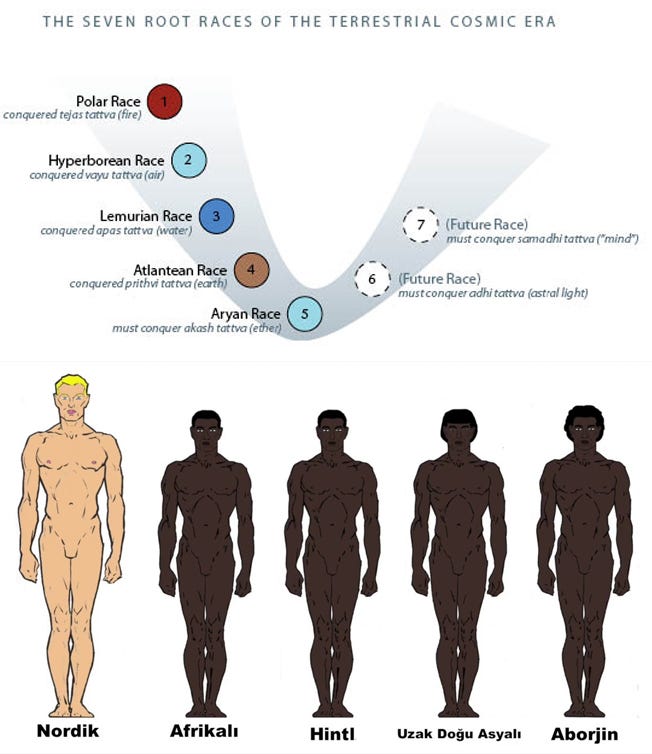
Hitler’s embrace of Darwinism, Nietscheanism and Eugenics were not as materialistic as modern scholars have been led to believe, since it was simply the material application of a luciferian set of concepts first promoted by Helena Blavatsky.
While Germanic branches of this Luciferian society occupied the passions and thoughts of the inner elites among the Nazi SS, an exoteric pseudo Christian front would be promoted for the un-initiated masses.
This fake Christian movement took the form of the German Christians, which emerged with Hitler’s 1933 acquisition of totalitarian power as Germany’s Fuhrer.
How Hitler Remade Christianity
The Berlin leader of the German Christians was named Dr. Reinhold Kraus, who demanded that Christianity be re-defined in accord with the ambitions of the new 1000 year Reich envisioned by the Nazi high command.
As such, Kraus believed that the church must be purged of everything “Un-German in worship and confession; liberation from the Old Testament with its Jewish morality of profit and its stories of cattle traders and pimps”.
In Hitler’s perverse version of Christianity, two of the ten Commandments were removed (including thou shalt not kill and steal) while several new commandments were added, including ‘thou shalt honor your Fuhrer’[1].
The Reichs Bible’s revamped Commandments read in full:
1) Honor God and believe in him wholeheartedly.
2) Seek out the peace of God.
3) Avoid all hypocrisy.
4) Holy is your health and life.
5) Holy is your well-being and honor.
6) Holy is your truth and fidelity.
7) Honor your father and mother — your children are your aid and your example.
8) Keep the blood pure and your marriage holy.
9) Maintain and multiply the heritage of your forefathers.
10) Be ready to help and forgive.
11) Honor your Führer and master.
12) Joyously serve the people with work and sacrifice.
Additionally, biblical stories that suggested Jesus had Jewish heritage were re-written, even going so far as to proclaim that Jesus was not the son of God, but rather the product of Mary’s midnight tryst with a pure blood Roman soldier.[2]
It should come as no surprise that Hitler also removed the entire Old Testament from the Reich Bible ensuring that any connection to Jewish culture would be severed. The Nazi Reich Bible also rewrote all sections of the New Testament that had made references to the Jewish heritage of either Jesus or his apostles, recasting them as Aryan supermen.
In The Aryan Jesus: Christian Theologians and the Bible in Nazi Germany, Susanna Herschel wrote that, “Nazi theologians invented a narrative that Galilee, the region in which much of Jesus’ ministry took place, was populated by Assyrians, Iranians, or Indians, many of whom were forcibly converted to Judaism. Jesus, therefore, was actually a secret Aryan, who was opposed and killed by the Jews.”
Hitler’s disdain for the Jews as an inferior genetic stock is no secret, but his disdain for Christianity is far less understood.
On October 10, 1941, Hitler wrote, “Christianity is a rebellion against natural law, a protest against nature. Taken to its logical extreme, Christianity would mean the systematic cultivation of the human failure. ”
The reason for this hatred was outlined on July 12, 1941 when he expressed his disgust for the Jewish origins of Christianity and his assertion that his idealized National Socialism could never co-exist with religion: “National Socialism and religion cannot exist together…. The heaviest blow that ever struck humanity was the coming of Christianity. Bolshevism is Christianity’s illegitimate child. Both are inventions of the Jew. The deliberate lie in the matter of religion was introduced into the world by Christianity…. Let it not be said that Christianity brought man the life of the soul, for that evolution was in the natural order of things.”
On October 19, 1941, Hitler equated the plague with Christianity while simultaneously celebrating an imagined ‘pureness’ of the ancient pagan world: “The reason why the ancient world was so pure, light and serene was that it knew nothing of the two great scourges: the pox and Christianity.”
That same year, Hitler’s personal lieutenant and secretary, Martin Bormann noted that “National Socialism and Christianity are irreconcilable.”
Of course, the evidence of mass human sacrifice, war, pillaging and rape practiced among pagan Teutonic rituals was conveniently ignored by the Fuhrer, who rebranded Christian rituals from Christmas, Marriage and Baptisms to take on Nordic pagan characteristics.
Christian Rituals Rebranded
The Nazi SS discouraged traditional church ceremonies in favor of “marriage consecrations” (Eheweihe), while Christmas was rebranded as ‘Jul Fest’ when the Nazis took power in 1933, which began to emphasize the Winter Solstice origins of the holiday. Santa Claus was rebranded from a Christian saint and began to be depicted instead as Odin, and both Mary and Jesus were as blond Aryans.

Christian baptisms were increasingly replaced with ‘name giving ceremonies’ officiated by a Nazi officer at an alter, often featuring a portrait of Adolf Hitler.
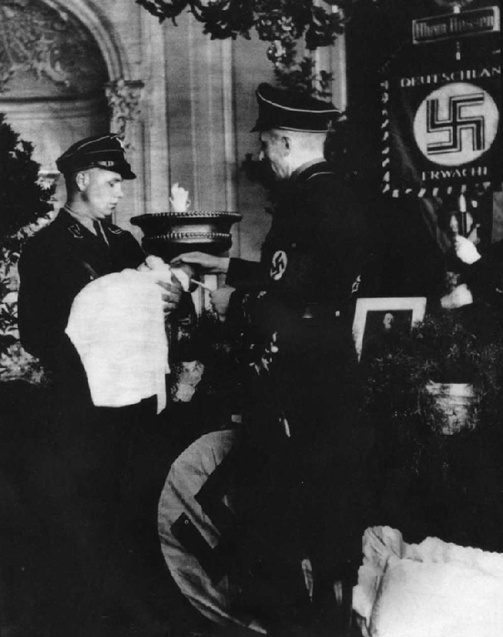
Despite his use of certain Christian terms in his public speeches and such writings as Mein Kampf, the truth was that Hitler despised the Bible, writing in 1940:
“The religions are all alike, no matter what they call themselves. They have no future—certainly none for the Germans. Fascism, if it likes, may come to terms with the Church. So shall I. Why not? That will not prevent me from tearing up Christianity root and branch, and annihilating it in Germany… We will wash off the Christian veneer and bring out a religion peculiar to our race.”[3]
According to Prussian SS officer Hermann Rauschning, Hitler described his views on Christianity, saying:
“Our peasants have not forgotten their true religion. It still lives… The peasant will be told what the Church has destroyed for him: the whole secret knowledge of nature, of the divine, the shapeless, the daemonic… We shall wash off the Christian veneer and bring out a religion peculiar to our race…through the peasantry we shall really be able to destroy Christianity because there is in them a true religion rooted in nature and blood.”[4]
Despite attacking both Christianity and Judaism, Hitler and his fellow Ariosophist/Thule occultists saw the value in the institution of Christianity and Zionism as tools for geopolitical control. They even went as far as to ensure that the German churches would serve as extensions of the state- loyal to the surrogate God of the state itself.
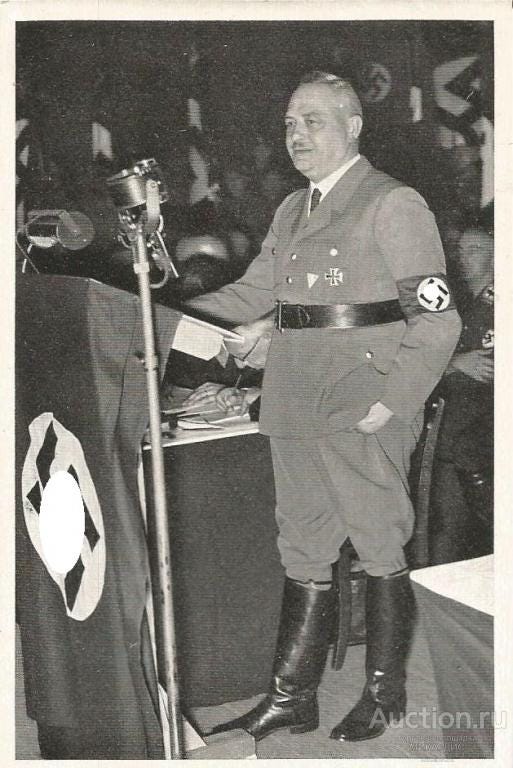
This view was expressed by Hans Kerrl, Nazi Minister of Church Affairs, who stated:
“Dr Zoellner and [Catholic Bishop of Munster] Count Galen have tried to make clear to me that Christianity consists in faith in Christ as the son of God. That makes me laugh… No, Christianity is not dependent upon the [Apostles’] Creed… True Christianity is represented by the party, and the German people are now called by the party and especially the Fuehrer to a real Christianity… the Fuehrer is the herald of a new revelation.
We are no theologians, no representatives of the teaching profession in this sense, put forth no theology. But we claim one thing for ourselves: that we place the great fundamental idea of Christianity in the center of our ideology [Ideenwelt] – the hero and sufferer Christ himself stands in the center.”[5]
Zionism as the Foundation of a New Order
During his time managing the Ahnenerbe, Reichsfuher Heinrich Himmler interfaced closely with Adolf Eichmann, chief minister responsible for ‘Jewish Affairs’ that oversaw the creation of the Ghetto system in Germany.
As part of the solution to eliminating untermenschen Jews from Europe, Eichmann- a kabbalist practicing Nazi, also led in the crafting of the Haavara Agreement in 1933 with the British Empire, establishing Nazi support for the transfer of Jews to British-Mandate Palestine in preparation for the creation of a Jewish state. The 1933 commemorative coin minted by Nazi Germany below celebrated that agreement.
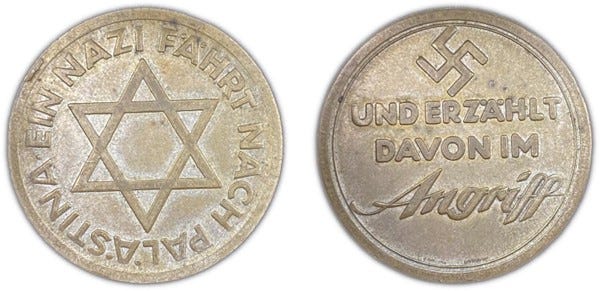
The Jewish Virtual Library notes that:
“The Haavara transfer was a major factor in making possible the immigration of approximately 60,000 German Jews to Palestine in the years 1933–1939, and together with the money invested by the immigrants themselves, in providing an incentive for the expansion of agricultural settlement and for general economic development. It also served as a model for a similar arrangement with the Czech government and the immigration of several thousand Jews on the eve of World War II.” [6]
Before his execution, Life Magazine interviewed Adolf Eichmann (who had learned Hebrew in order to study the Kaballah) about his relationship with Zionism.
Eichmann stated:
“[H]ad I been a Jew, I would have been a fanatical Zionist. I could not imagine being anything else. In fact, I would have been the most ardent Zionist imaginable”.[7]
Hitler’s simultaneous alliance with Grand Mufti Haj Amin (Muslim Brotherhood asset of the British Empire installed as Grand Mufti by the British Empire) is not contradictory to his pro-Zionist policy outlined by the Havarra Agreement.
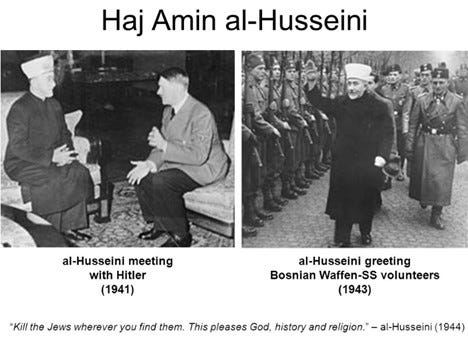
In fact, the obsessive demands of Haj Amin to kill all the Jews, and the fascist-admiring networks of Vladimir Jabotinski’s Irgun Greater Israel fanatics obsessed with destroying the Arabs living in the vast region of ‘Greater Israel’ was all part of the same formula of geopolitical control of chaos within a strategically important area of the globe where all major civilizations intersected.
So, What DID the Nazis Believe?
The late American historian William Laurence Shirer wrote that, “under the leadership of Rosenberg, Bormann and Himmler—backed by Hitler—the Nazi regime intended to destroy Christianity in Germany, if it could, and substitute the old paganism of the early tribal Germanic gods and the new paganism of the Nazi extremists.”[8]
As noted above, the Nazi leadership were composed of followers of an occult sect called Ariosophism, led by a mystic rune-obsessed poet named Guido von List who simply took Madame Blavatsky’s theosophy and infused an Aryan racial superiority twist with a heightened focus on Wotan (Odin) myths.
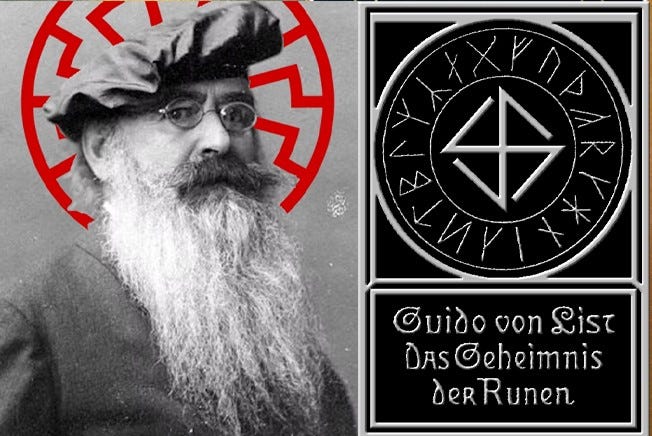
The Ariosophists were an outgrowth of an earlier occult order called ‘The Theosophists’ created by Madame Helena Blavatsky in 1875.
Blavatsky’s thesis was nested within a conspiratorial worldview that promoted a belief in a Great White Lodge of Ascended Masters living in Shamballah who would communicate telepathically to ‘special’ mediums such as Blavatsky in order to pass on higher gnostic wisdom in a battle with a ‘Great Black Lodge’ of evil priests.
Of course, Blavatsky and her followers were led to believe that they were on the side of angels in this cosmic battle, being promoters of ‘light’ and life. However, Blavatsky also made it clear that her new world religion would be devoted to Lucifer, and would require the destruction of Christianity.
Describing her devotion to Satanism, Blavatsky wrote:
“That which the clergy of every dogmatic religion – pre-eminently the Christian – points out as Satan, the enemy of God, is in reality, the highest divine Spirit – (occult Wisdom on Earth) – in its naturally antagonistic character to every worldly, evanescent illusion, dogmatic or ecclesiastical religions included” (Blavatsky 1888a, Vol. II, 377).
Driving the esoteric Luciferian inner core of Blavatsky followers, we had Ariosophist high priests such as Guido von List, Lans von Liebenfels, who published a Teutonic mystical magazine called ‘Ostara,’ to which a young Hitler was a devoted subscriber.
In this sect, the swastika and other rune symbols like the Othala rune, Ehlaz/life rune, Sig runs (later used by SS), and wolfsangle were treated as sacred images endowed with magic power.
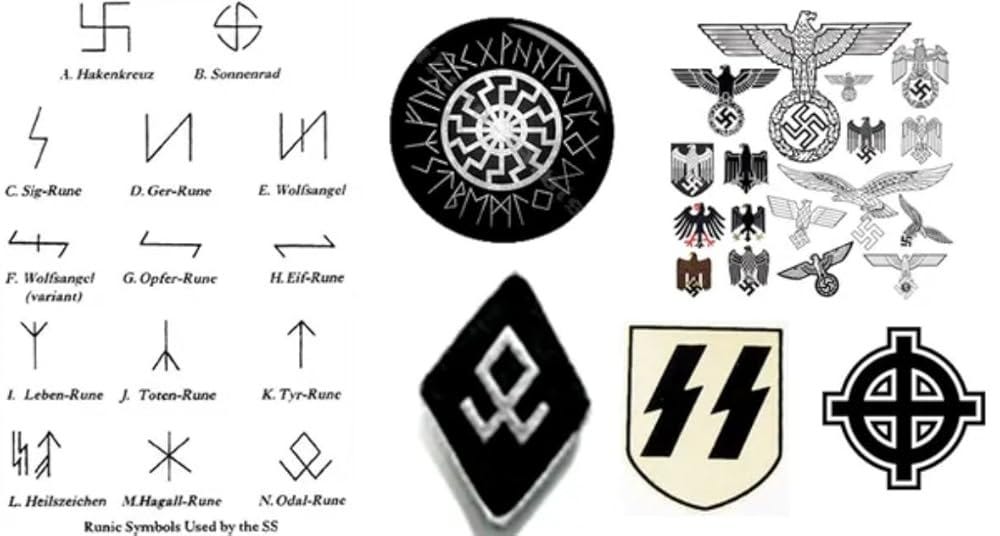
Guido von List had organized his sect into an inner and outer core, with the “elect” learning a secret interpretation of the runes under an elite occult society called the High Armanen Order, where von List himself served as Grand Master.
This racist occult Aryanism with its Theosophical aim to infuse Hindu and Buddhist mysticism into a new post-Christian age became an extremely popular phenomenon among the noble families of Europe during this period. The aim was to use a perverse interpretation of eastern spiritualism devoid of substance and create a new order premised on an “Age of Aquarius,” which would supersede the obsolete “Age of Pisces” that represented the obsolete of reason exemplified by the likes of Socrates, Plato and Christ.
Out of the High Armanen Order soon grew another secret occult organization called the Thule Society, which saw Rudolf Hess, Hans Frank, Hermann Goring, Karl Haushofer and Hitler’s coach Dietrich Eckart as leading members.
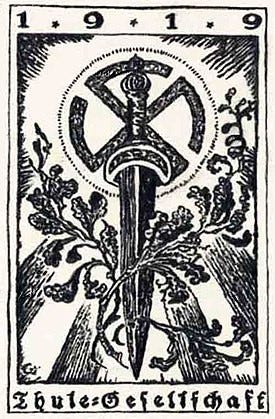
Another influential German occultist was Theosophical Aryan supremacist Franz Hartmann, who also did much to oversee the growth of a Germanic version of Theosophy. Liebenfels and Hartmann would promote a German branch of New Templars, and both would associate closely with another occult secret society known as ‘The Thule Society’ that sought, like the covens of earlier times, to use long-haired priestesses in sacred orgies, seances, and soothsaying.
According to occult scholar Samuel Koehne, Liebenfels “supported the notion of Christianity as a “racial cult religion,” interpreting the Bible through a bizarre exegesis that argued the Old Testament taught the dangers of racial admixture, supported Moses as a “Darwinist” and preacher of “racial morality”– rewriting the Ten Commandments as laws for racial purity––and advocated “a dualistic heresy, which describes the battling forces of Good and Evil, typified by the Aryan ace men and their savior Frauja, a Gothic name for Jesus, who calls for the sacrificial extermination of the sub-men, the “apelings” and all other racial inferiors”[9]
The thrust of the philosophy promoted by the Ariosophists and Thule Society priesthood posited that Christianity was a Jewish plot to shackle the pure spiritual culture of the Wotan/Viking spirit of the pure blooded Teutonic warriors that inhabited the Black Forrest under the Roman Empire. This earlier pure pagan culture was one managed by a druidic high priesthood, which used Runes as a technique of spiritually interfacing with the pagan deities/demons from beyond.
This occult secret society shaping the Nazi high command organized a central headquarters named ‘Wewelsberg Castle,’ and the beliefs, Templar revival and satanic practices of this Nazi high command will be explored in greater detail in our next segment of ‘Real Patriots Don’t Think Like Hitler’.
[2] The Nazi Reichs Bible is treated by Luke Harrington’s The Truth About Nazi Germany’s Very Different Version Of The Bible, Grunge Magazine, 2021
[3] Cited in Nazis and the Occult by Paul Roland, Arcturus Publising Ltd, 2002, p. 178
[4] Richard Cavendish, “Mythology – an illustrated encyclopaedia”, Twickham, 1998
[5] Fascism, Totalitarianism and Political Religion, Roger Griffin (Editor), p. 98 Routledge; 1st ed. (2006)
[6] www.jewishvirtuallibrary.org/haavara
[7] A. Eichmann, “Eichmann Tells His Own Damning Story”, Life Magazine, Volume 49, Number 22, (28 November 1960), pp. 19-25, 101-112; at 22.
[8] Cited in William L. Shirer; The Rise and Fall of the Third Reich; Secker & Warburg; London; 1960; p. 240
[9] Samuel Koehne, “Were the National Socialists a “Völkisch” Party? Paganism, Christianity, and the Nazi Christmas,” Central European History 47, No. 4 (December 2014): p.767





